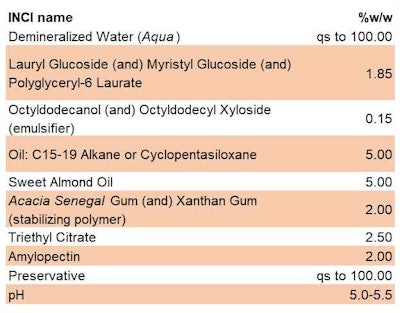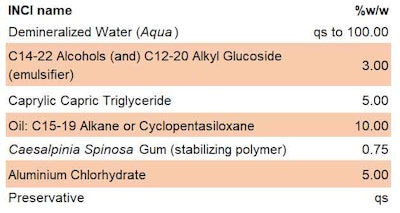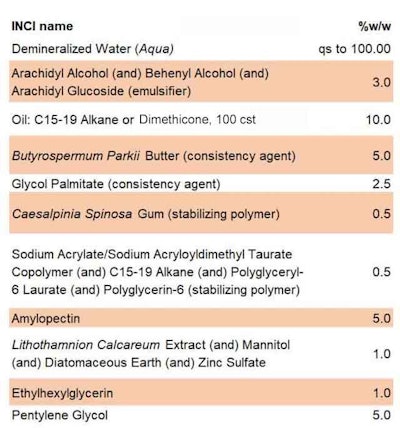
The deodorant market is small but steadily increasing, with an average annual growth estimated at 10.3% between 2022-2027. Within this segment, aerosol deodorants have the largest market share but are becoming increasingly less appreciated by consumers.1 This is because the idea of high-performing yet natural and sustainable products has grown in the minds of consumers – and the packaging and gas propellant-rich formulas for such products are at odds with these tenets.
Log in to view the full article
The deodorant market is small but steadily increasing, with an average annual growth estimated at 10.3% between 2022-2027. Within this segment, aerosol deodorants have the largest market share but are becoming increasingly less appreciated by consumers.1 This is because the idea of high-performing yet natural and sustainable products has grown in the minds of consumers – and the packaging and gas propellant-rich formulas for such products are at odds with these tenets.
In turn, emulsions have become a popular format for antiperspirant and deodorant (AP/deo) formulas, but they are also being scrutinized as they often contain silicone oils2 – controversial ingredients in the eyes of consumers due to environmental concerns.3 Indeed, today’s deodorant launches are driven by ethical and environmental claims that also emphasize respect for the skin.1
Responding to these concerns, the author’s company recently explored how to develop stable, silicone-free AP/deo formulations that maintain silicone-like sensory properties. Described here are the formulation methodology, sensory testing and results, ultimately to identify ingredients to achieve both sustainable and sensorial benefits.
Formulation Methodology
Initially, market and bibliography analyses were carried out to choose the most common active ingredients and biodegradable and/or natural oils comprising AP/deo products. The two types identified were:
- Active ingredients with antiperspirant properties that block pores using astringents to reduce sweat production, or with deodorant properties that neutralize the smell of sweat without blocking sweat production; and
- Silicone oils that bring sensory benefits and support the efficacy of the formula by providing non-greasy, quick-drying effects while being compatible with the active ingredients.
The most frequently used silicone oils in deodorants are dimethicone, dimethiconol and cyclopentasiloxane, which are often used in combination; and cyclic silicones such as cyclopentasiloxane and cyclomethicone.1 With this in mind, biodegradable alkane emollients were studied as replacements for dimethicone and cyclopentasiloxane.
The biodegradable alkane emollients were challenged for their compatibility with modern AP/deo actives.4 More specifically, the compatibility and stability of emulsifiers and polymers with active ingredients, such as the classic aluminium chlorohydrate antiperspirant, or trending antiperspirant ingredients including triethyl citrate, zinc oxide, algae or plant extracts and absorbing agents were evaluated.
The most promising results led researchers to develop three test emulsions, including two roll-ons and one balm, following current market texture trends (see Formulas 1-3). These formulas were then tested for sensory effects.
 Formula 1. Test Roll-on 1
Formula 1. Test Roll-on 1
 Formula 2. Test Roll-on 2
Formula 2. Test Roll-on 2
 Formula 3. Test Balm
Formula 3. Test Balm
Sensory Analysis
Sensory analyses were carried out with the three test products, which were used by 12 expert panelists and 60 female consumers to determine silicone vs. silicone-free formula preferences.
Expert panel: A 12-subject panel compared the C15-19 alkane-based version to the silicone-based version of the formulas by evaluating the sensoriality of the emulsions on the forearm and scoring eight selected descriptors from 1 to 10. The descriptors evaluated included the following: freshness perception, ease of spreading, penetration and thickness sensation during application; dry and sticky sensations, 1 min after application; and dry and softness sensations, 2 min after application. Results are shown in Figure 1a-c.
 Figure 1. Comparative expert panel sensory evaluation results between alkane-based and silicone-based emulsions
Figure 1. Comparative expert panel sensory evaluation results between alkane-based and silicone-based emulsions
Consumer testing: A usage evaluation was carried out in 60 female consumers who applied the products in their underarm areas then answered questionnaires marked by four levels of agreement. The consumers evaluated how pleasant the emulsions felt during application, including the sense of freshness and ease of spreading. Consumers also assessed properties of quick drying, non-stickiness, comfort, smooth/moisturized/dry skin sensation, non-drying effect and residual presence after application; they additionally indicated if they would use the product on a daily basis. Figures 2a-c show the results.
 Figure 2. Comparative consumers usage evaluation results between alkane-based and silicone-based emulsions
Figure 2. Comparative consumers usage evaluation results between alkane-based and silicone-based emulsions
Sensory Results
Preference mapping was used to overlay the formula ratings by experts and consumers, which highlighted two groups corresponding to the consistency of the emulsions regardless of the nature of the oil. The results showed that 40% to 60% of consumers liked the balm formula, which is a relatively newer product format, as it was perceived to spread easily and impart soft and moisturized skin without drying effects, e.g., itchy skin, lasting all day long. Notably, the comfort sensation of this format was highly appreciated.
In comparison, 60% to 80% of consumers preferred roll-on emulsions. This classic format imparted a sense of freshness during application and quick-drying effects – essential benefits for consumers. The moisturizing effect and skin softness were the main advantages of the format.
Discussion
In the Formula 2 roll-on, the alkane emollient formula offered the same sensory profile as the cyclopentasiloxane formula but with a better quick-drying effect. This version was also less sticky than the cyclic silicone with the same level of satisfaction for softness and moisturization. Panelists noted that the sensoriality provided by the alkane emollients was not significantly different from that of cyclopentasiloxane.
In the case of Formula 1, characterized as a thin, quick-penetrating and fast-drying formula, it was demonstrated that alkane emollients contributed to easy spreading, an absence of tackiness and fresh sensation on the skin. Moreover, consumers appreciated that the formula provided a soft, moisturized skin feel without any drying effects.
Finally, for Formula 3, the balm formula, the alkane-based emulsion dried quicker on the skin with great spreadability, delivering freshness and pleasant sensation with less residual film perception than the formula containing dimethicone. This demonstrated how alkane emollients could offer the same appreciable physical properties as dimethicone without its drawbacks.
Conclusion
As the preference mapping results showed, replacing cyclic silicones and low viscosity dimethicones with alkane emollients in silicone-free roll-on and balm deodorants was acceptable to both consumers and expert panelists in terms of sensory performance. This suggests alkane emollients could offer an alternative to silicones in AP/deo formulas, thus meeting today’s consumer demand for eco-conscious and sustainable solutions.
References
1. Euromonitor. (Accessed 2023, Apr 19). 2022 Global deodorant market. Beauty and Personal Care 2023 Passport.
2. Guillon, D. (2005, Jul 2). Les antitranspirants et formulation des roll-ons. Ecole Nationale Supérieure de Chimie de Rennes.
3. Ermenlieva, N., Georgieva, E. and Milev, M. (2020, Oct 7). Antibacterial and antifungal activity of antiperspirant cosmetic products. Journal Inter. Available at https://www.journal-imab-bg.org/issues-2020/issue4/vol26issue4p3374-3377.html
4. Lukacs, A., Korting, H.C., BraunFalco, O. and Stanzl, K. (1991). Efficacy of a deodorant and its components: Triethyl Citrate and perfume. Journal of the Society of Cosmetic Chemists. Available at https://tinyurl.com/2mfsm4md











